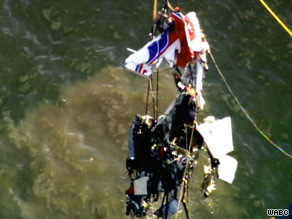
Investigators probing last weekend’s fatal aircraft collision over New York’s Hudson River focused Friday on an air traffic controller, though union leaders angrily said the controller could have done nothing to prevent the crash.
In a report, the National Transportation Safety Board said that the controller at New Jersey’s Teterboro airport did not advise a pilot of potential traffic when he handed off radar monitoring of the plane to the tower at Newark airport at 11:52:20 a.m. Saturday. But, union leaders said, the helicopter was not visible on radar scopes until 11:52:27, seven seconds after the transfer. Union leaders said the NTSB’s statement that the controller could see the helicopter on his radar screen, and its implication that he could have provided a warning, is wrong. The open disagreement, which violates the normal protocol of NTSB investigations, capped a bruising week for air traffic controllers. Following the crash, the Federal Aviation Administration placed two controllers at the Teterboro airport on administrative leave, saying one of them — a manager — was wrongly out of the facility at the time of the crash. And the other controller, who was monitoring the Hudson River airspace, was inappropriately engaged in a private telephone conversation, the FAA said. Sources close to the investigation said the controller was talking to his girlfriend. Watch amateur video of the moment of impact » The NTSB report further drew attention to controllers, saying that audible warnings sounded and visual warnings appeared on their computer screens 20 seconds before the collision, but that controllers did not recall hearing them. Ray Adams, president of Newark airport’s branch of the National Air Traffic Controllers Association, said Friday that the “conflict alerts” in the Hudson River’s busy airspace are so frequent that they “tend to become part of the background noise.” The NTSB report, though disputed in parts, provides the most detailed timeline of events to date of the collision. Nine people died when a Piper PA-32-R-300 collided with a helicopter operated by Liberty Helicopters, a sightseeing company. According to the report, the Piper departed the Teterboro airport at 11:49 a.m.
Don’t Miss
Divers find final 2 bodies from Hudson crash
The Teterboro controller advised the airplane of another helicopter in the area and instructed the plane to remain at or below 1,100 feet. Planes operate in that airspace under “visual flight rules,” which place responsibility on avoiding other aircraft in the pilots’ hands. Pilots must “see and avoid” other aircraft. After warning the pilot about the first helicopter, the controller made a “non-business” telephone call, the NTSB said. At 11:52 a.m. — three minutes after the plane took off — the helicopter departed New York’s West 30th Street Heliport. The helicopter was not communicating with controllers, nor was it required to, the NTSB said. Soon thereafter, the Teterboro controller instructed the Piper pilot to switch his radio to Newark airport’s controllers for further instructions. Immediately afterward, the Newark controller called the Teterboro controllers to request that the airplane turn to the southwest. As the Newark controller was providing the suggested heading to the Teterboro controller, the Piper pilot was acknowledging the frequency change to the Teterboro controller, the NTSB said. At the time of the radar handoff, “there were several aircraft detected by radar in the area immediately ahead of the airplane, including the accident helicopter,” the NTSB said. “The Teterboro tower controller, who was engaged in a phone call at the time, did not advise the pilot of the potential traffic conflicts.” However, the Newark controller called the Teterboro controller to request that the plane change course, the NTSB said. The Teterboro controller “made two unsuccessful attempts to contact the pilot,” with the second attempt occurring 24 seconds before the collision. NATCA’s Adams hotly disputed the suggestion that the Teterboro controller could see the helicopter on the radar scope. “That is incorrect,” Adams said. “The target [helicopter] did not appear on the radar scope” until after the handoff, he said. Referring to the Teterboro controller, Adams said, “He is not culpable in this crash.” Adams also said the controller’s personal phone call “was not what we’d consider a reason or a factor in the crash.” Adams and others declined to identify the controller, but said he has many years of experience. The NTSB said it was investigating what “role that air traffic control might have played in this accident.” But it cautioned against drawing conclusions, saying “any opinions rendered at this time are speculative and premature.”
NATCA spokesman Doug Church, noting that the air traffic controllers union is a party to the NTSB’s investigation, acknowledged the public dispute was unusual. “This is an extremely rare moment,” he said. “We value our party status; this is not a step we take likely.” Also Friday, the FAA said it had convened a working group to review operating procedures over the Hudson and East rivers. The group will recommend safety improvements to FAA Administrator Randy Babbitt in two weeks, it said.